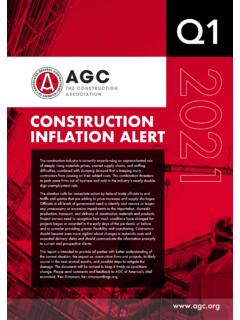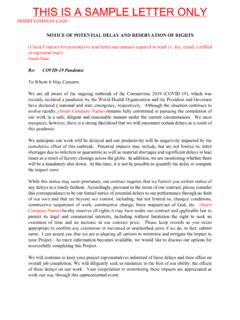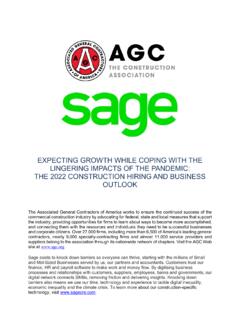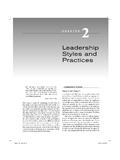Transcription of Workforce Development Solutions Key Takeaways from AGC …
1 1 Workforce Development Solutions Key Takeaways from AGC of America s Inaugural National Construction Industry Workforce Summit The Associated General Contractors of America (AGC) convened its inaugural National Construction Industry Workforce Summit in St. Louis, Missouri on October 13, 2021. The event was designed to bring leaders in construction and Workforce Development communities together to identify effective existing Solutions and craft potentially effective new Solutions for the recruitment, training and retention of construction Workforce . Attendees included: people who work for construction firms and are involved in Workforce Development efforts; staff of AGC of America chapters who are involved in Workforce Development efforts; members of the construction education and training community, including high school and community college career and technical education instructors, union and open shop training personnel and others involved in preparing future construction workers.
2 At its broadest level, the objective of the summit was to try to unite the many diverse, and disparate construction Workforce Development efforts that already exist. Many of these programs are extremely innovative and effective. But all too often operate in isolation, without awareness of, or coordination with, other Workforce Development efforts. This summit brought together the people involved in these efforts to share what they are doing and learn from each other. To that end, attendees spent most of their time working together in small group sessions. This included breakout sessions focusing on sharing details about successful measures. They also spent time brainstorming Solutions to some of the industry s primary Workforce Development challenges, including attracting more diverse workers, developing and upskilling their existing workers and finding ways to retain new workers.
3 The summit also featured Ted Talk-style presentations from six different innovative Workforce Development programs . These programs were selected to represent a cross-section of what is possible in Workforce Development . All attendees had the opportunity to ask questions about these programs and evaluate whether creating similar local programs made sense. AGC of America concluded the summit with two challenges to all attendees. The first was to understand, appreciate and operate with the knowledge that they are not alone; to look for opportunities to collaborate with other Workforce Development programs ; and to unite our collective efforts. The second challenge was to take at least one idea covered during the summit and implement it back home. This document is designed to serve as a resource for Summit attendees and other members to use as they identify Workforce Development measures to put in place locally.
4 2 Key Takeaways Summit attendees self-selected the Workforce Development aspect that was of most interest: recruitment, training or retention. To follow is a summary of those conversations, including examples of strategies already in place that are working and suggested Solutions that the Summit attendees crafted on site. Recruitment Strategies that are working - Implement a Sign and Stay bonus program for skilled trades. Several construction firms noted they have had success putting in place these types of program that offer an hiring bonus and a comparable stay bonus when the employee has stayed for a certain length of time, such as one year. - Firms and chapters are participating in Career Days with specific high schools, particularly technical schools. These firms develop strong working relationships with the schools and spend a lot of time on campus setting up and supporting construction-specific programs that can then serve as a pipeline for new craft people into that firm.
5 - Other firms and chapters are using Career Fairs to bring students from multiple high schools to a single point such as a fair ground where they can be exposed to a wide range of craft skills, construction equipment and construction technology. - Some states, notably Florida with its Florida Apprenticeship program offer workers compensation waivers for firms that hire students out of local high schools. In exchange, contractors agree to pay those high school apprentices the same pay rate. - Engaging with middle and high-school aged girls and their mothers during PowerUp sessions that offer after-hours demonstration and introductions to construction careers to help make them comfortable with the idea of working in the industry. - Using digital advertising and social media to reach high-potential industry recruits as well as targeting key influencers such as coaches, teachers and parents.
6 - Working with state education authorities including the Texas Education Agency to create a training program for construction industry outreach specialists. These specialists then work with high school students to help them explore different career paths within the industry and work in coordination with local high school guidance counselors. - Firms and AGC chapters are using virtual reality glasses to provide OSHA10 and OSHA30 hour training with high school classrooms. Other firms are using VR headsets to safely expose high school students to different construction opportunities, including equipment operation and welding. 3 - Some firms and chapters have worked with Workforce investment boards, like the Texas Workforce Commission, to secure funding for scholarships for childcare so their parents can earn a living in careers like construction. - AGC chapters have created special construction academies during the summer.
7 These academies offer multi-week, paid-work opportunities for rising junior and senior high school students. The students split their time between CTE programs and being on actual construction job sites. - The AGC Georgia chapter hosts Trade Talks where they bring in high school guidance counselors, explain the construction career opportunities that are available, what it takes to qualify for them and how much students can earn in their careers. - Other chapters are working with local school districts to offer intro to construction careers programs to younger students. In one state, Georgia, students are being introduced to construction careers at the second-grade level. - Construction firms are being more strategic about who they send to do the recruiting. They are sending diverse role models into school programs and other recruiting events to speak to increasingly diverse student populations.
8 - One school official from Oklahoma recommended that when construction firms visit schools that they bring more hands-on activities, bring teachers out to job sites and recruit older, semi-retired contractors, to teach. - Many construction firms and chapters also talked about the work they are doing to create single online job boards for all available local construction career opportunities. This way potential applicants have a one-stop portal for finding available career opportunities. 4 New Ideas from Summit Attendees - Promote the fact workers can pursue careers in construction and earn college degrees at the same time. Many construction career paths offer young workers an opportunity to earn an Associate in Applied Science degree while they are learning their craft. They can then transfer those credits over when they enroll in construction management and other four-year programs .
9 In addition, some apprenticeship programs have partnered with colleges so participants can also earn degrees. - Modernize the way to recruit people into this industry. Younger generations are keyed into social and digital media that is where they get much of their information. The construction industry needs to do its recruiting in the online community, in addition to in-person events. - Make educators feel like an extension of the industry. Bring them to job sites explain the earning potential in the construction industry, and physically bring them to construction firm offices so they can experience the many different type of career opportunities that are available in construction. - Play to the industry s strengths highlight the sense of accomplishment that comes with building structures. Talk about the teamwork aspects of construction, the fact the challenges are different each day, the sense of accomplishment from I built that , and the significant earning potential in construction.
10 - Bring the construction experience to the schools. This could include providing classes with a direct feed to construction site cameras. Providing schools with virtual reality gear so them can experience simulated construction environments. And find recent graduates from schools working in the industry to share their experiences with students. - Labor and management should work together to improve entrance into the industry. Individual trades have different time requirements, application periods and expectations. No interested individual should be turned away if a specific trade doesn t have opening in its apprenticeship programs . The trades need to create portals to track openings and improve reciprocity so individuals can begin earning and learning day one even if they ultimately prefer a different trade. - Consider community events to raise the profile of the industry. Go to community festivals and fairs.













